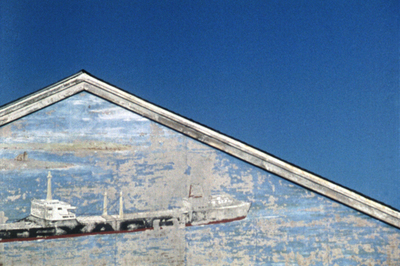Ann Arbor Film Festival, Day 4: Japanese animation, juror Rebecca Myers
Tian-Jun Gu and Greg Wachtenheim, both students in the University of Michigan's screenwriting program, are blogging for AnnArbor.com from the 49th Ann Arbor Film Festival. Here are their reports from two Day 4 programs on Friday.
“Midori-Ko” By Tian-Jun Gu
Kurosaka Keita is one of Japan’s most renowned independent animators. His grotesque style stands in sharp contrast to the anime fare that is typically associated with Japan. His work is scatological, morbid, sensual, surreal, and utterly engrossing. Three pieces of Kurosaka’s work was shown, curated by Jonathan Hall, Ph. D., and co-presented by the UM Center for Japanese Studies.
“Midori-Ko” (2010), Kurosaka’s first feature length “narrative” animation, was over 10 years in the making and contains more than 20,000 hand-drawn images. It’s about a dystopian Japan suffering from a food shortage. The vegetarian protagonist comes upon a mysterious plant creature that could end the food shortage, but she vows to protect it as it begins to develop human qualities. This becomes exceptionally challenging when the rest of the community is interested in eating the creature. What’s unsettling is that in the end, the protagonist betrays the creature and fights her own community in order to have the creature all to herself to eat.
“Agitated Scream of Maggots” (2007) was a music video Kurosaka created for the metal band Dir en Grey. The animation style is similar to “Midori-Ko” and portrays a child’s anger at the destructive adults around her, culminating in violent results.
“Personal City” (1990) is a live action stop-motion piece that originated out of Kurosaka’s struggle with an upset stomach over spoilt potato salad. It begins with a man on a toilet and moves through various cityscapes, landscapes, characters, and memories to eventually come full circle back to the toilet. It was influenced by Ito Takashi, who was well known for stop-motion where the perspective would “fall” into mirrors and photos, thus creating their own space. Another influence was Kurosaka’s mentor Toshio Matsumoto, an avant-garde filmmaker who often uses a “flicker effect” in his films. While it may be live action, its themes of consumption, reproduction, and destruction would continue to be seen in his later films.
The tragedies befalling Japan kept Kurosaka Keita from coming to the Q & A, so he filmed a video message for the audience. Jonathan Hall translated. I’m paraphrasing here, but Kurosaka revealed that he felt he should remain in the country to join in the “fate with his countrymen.” This could be because of the translation, but I thought “fate” was an interesting term to use. In Kurosaka’s brief biography in the pamphlet, it notes that as a teenager, he was immensely interested in painting, particularly oil painting. He would use this medium to document his grandfather’s ailing health and ultimately create “death portraits” of his grandfather after he passed away. In all of his work, death looms over the pieces.
Hall stated that Kurosaka is interested in how reproduction is tied to consumption but also wants to detail the expulsion, decay, and death that must be tied to those states as well. While Kurosaka’s presence would have certainly been welcome to shed light on his work, Kurosaka encourages the audience to draw their own wild conclusions. And in an eerie act of “fate,” it seems that is all the audience can do.

TIan-Jun Gu
Tian-Jun Gu is a senior in the Screen Arts and Cultures program with a sub-concentration in Screenwriting at the University of Michigan. Although born in Shanghai, China, he considers himself a Michigander. Film has been an integral part of his life but never a path he planned on taking. Originally enrolling in the University of Michigan as an engineer, he fell back in love with film through Hubert Cohen’s “Art of Film” class and cannot see himself doing anything else now.
Juror Presentation: Rebecca Meyers By Greg Wachtenheim
Rebecca Meyers screened five of her 16 mm films, all of which seemed to juxtapose man and nature. While none of these were narrative films, they all contained messages that became stronger in conjunction with one another.
“things we want to see” (2004) raised concerns about man’s destructive impact on the environment. The film began with footage of beautiful blue waters and immense glaciers, but ended with shots of fractured ice and sea lions resting on man-made buoys instead of its natural icy habitat. The soundtrack consisted of a recording of a New Year’s Eve party with people obnoxiously talking over one another. The way in which the human dialogue distracted from the stunning natural imagery created a sense of resentment towards mankind’s impact on nature.
“lions and tigers and bears” (2006) had the most direct interaction between human society and wildlife. Meyers’ process for making this film involved walking through Chicago, filming every animal she saw, whether it was real or artificial. Her footage included spiders, pigeons, and dogs, as well as a mural of whales swimming in a blue ocean on the side of a brick building, and a wire flamingo staring out a bedroom window. At times these natural and artificial worlds seemed to engage one another. The images that contained both skyscrapers and animals elucidate how strange of an environment our urban centers are for wild animals.

The longest of Meyers’ films, “blue mantle” (2010), is a quasi-documentary film that tells the tale of the “ocean graveyard” between Chatham and Provincetown, Massachusetts, where many shipping vessels have been lost. In the film, this locale serves as a battleground for man and nature. The periodic inserts of poetry serve as a form of narration throughout the film. Richard Wagner’s “The Flying Dutchman” was a strong influence for Meyers, an evident fact as she fittingly incorporated a series of paintings featuring ships in turbulent seas into her film. Footage of lighthouse beams being cut off by darkness showed that man was no match for the mighty forces of nature. However, a radio broadcast explaining that the transatlantic telegraph cable enabled shipping vessels to receive news and avoid dangerous territories, in addition to the image of a mighty ocean-liner cruising the seas, conveyed humanity’s attempt to conquer these treacherous seas. Perhaps counter intuitively, the footage of man’s successful aquatic endeavors was accompanied by an ominous choral score. However, it appears that in the end, nature won the battle over man, as the final poem featured tales of boats destroyed and lives taken by the ocean.
Meyers’ carefully planned presentation enabled the theme of her films to achieve its intended effect. Her films shared strong connections with one another. The inclusion and contrast of both man and animal was undeniable, but what made these films exceptional was the use of different media to portray each group. At times industrial images were accompanied by animal sounds, and images of nature were often shown along with offensive human and technological sound. Together, these films constituted a thorough examination of the interaction between civilization and Mother Nature.

Greg Wachtenheim
Greg Wachtenheim is a senior at the University of Michigan, majoring in Screen Arts and Cultures with a sub-concentration in screenwriting and a minor in Spanish. His love for creative writing and film has inspired him to pursue a career in screenwriting.

